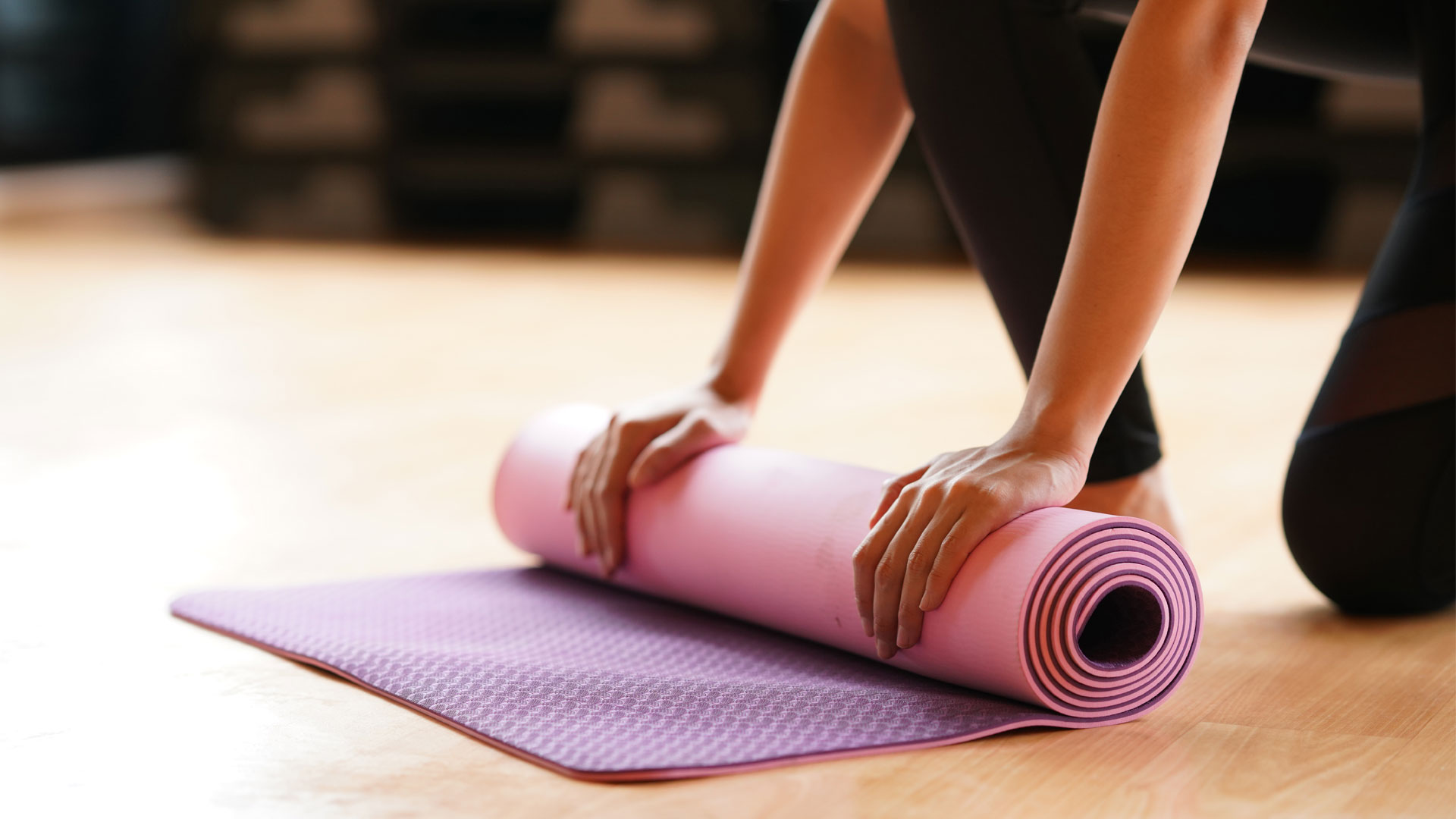Yoga for back pain: What you need to know
Find out everything you need to know about yoga for back pain, including if experts really think it's a good idea.

If you’re thinking about using yoga for back pain, we’ve got all the information you need. In this article, physiotherapist with over 25 years of experience, Mark Brownless tells Live Science whether back pain is actually muscular and whether yoga is really a good idea if you’re experiencing issues with your back.
So, whether you’ve been looking for a good quality yoga mat that you can use at home or in the office, or you aren’t sure if yoga is the right thing to do, this article should tell you what you need to know.
Please note, this is not an exhaustive article about back pain, and if you are in any doubt about whether you should use yoga for back pain, or have any other concerns about your body, then consult your family doctor or physical therapist.
For now though, here's what Brownless told Live Science about yoga for back pain.
- Related: Is yoga good for you?
Does yoga help back pain?
A survey by Forbes in 2016 found that 37 million people in the United States practiced yoga. To put it simply, yoga is a series of poses and stretches, coupled with breathing exercises, designed to help with conditioning the body. It can get far more involved and complex than that too, with different types of yoga, meditation, mind-body balance and so on.
If you are using yoga for back pain, or any other musculoskeletal problem, it should target that part of the body more than other areas. Yoga isn’t a magic bullet, however. If your back pain is related to sitting all day at work, then no amount of stretching is going to help if you don’t take breaks from sitting, assess your workstation and think about improving your posture. It’s not a case of ticking a box that yoga will counteract all of those habits.
But if you have tried to address the causative factors, and are still getting back pain, then yoga could be of use to help manage your symptoms.

Is back pain muscular?
You may have heard of people having a prolapsed or slipped disc in their back, or having degeneration / arthritis as a cause of their back pain. These are genuine conditions of course, but sometimes back pain is not as serious or significant as that. The majority of back pain doctors see is either classed as non-specific or mechanical, but what does that really mean?
Get the world’s most fascinating discoveries delivered straight to your inbox.
Often back pain is described as muscular or as a muscle strain, even by doctors, yet MRI scans never show this, and there is little or no evidence to say that there is actual damage to the soft tissues at all. In the doctor's office, an examination will most often produce the patient’s symptoms when they extend (arch) their back, where there is no load on the musculature. This movement is actually loading the joints in the lower back – the facet joints – and it is most commonly produced in patients with simple back pain. Yes, the overlying muscles can then spasm as a result, but clinical experience suggests that the cause of most simple back pain is not muscular.
If you're wondering about it, we have a feature discussing 'can yoga fix your posture' too.
If not muscular, then what?
I hear stories from patients of how their back "went out" when they bent down to tie their shoelaces or to pick up a pen. Clearly, if tying our laces was so dangerous, we would all be forced to wear slip-ons. So, it can’t really be one simple act that has caused the problem, but rather that it is the last straw from all the times you have done movements that place strain or excessive load on your back, and now one of those tissues is crying out for help.
If you did have a simple soft tissue strain, then this would take a month or two to settle, yet in the clinic, treatment over a week or two can make significant improvements; so it doesn’t fit that you’ve actually damaged some tissue.
• Related: Best resistance bands
Rather, it is more likely to be excessive stresses and strains on the low back causing pain by placing too much load through the soft tissues and causing them to fire off nerve signals to the brain that are interpreted as pain. It’s impossible to say whether these strains are to the muscles, ligaments or other soft tissues, and as we said above, they are not likely to be be damaged as such.
What about "no pain no gain?"
If you are just training – whether it’s for aerobic fitness or anaerobically using weights to get stronger – it’s probably going to hurt. Cardiovascular demand and load on your body will stress joints and muscles, and training in this way is what people really mean when they think of the "no pain, no gain" expression.
In general, this doesn’t apply to someone with a pain problem. If you have, in this case, back pain, and you do any form of training or rehabilitation that makes your back pain worse, in general, that can’t be making it better. Effectively you are stirring up the hornet’s nest, making you more sensitive to pain, and that isn’t going to improve things. Some studies have shown that patients can push into pain and get good short-term results, but these have been within a supervised physical therapy environment, and are best avoided when you are on your own.
Essentially, if you are using yoga to treat your back pain, it really doesn’t make sense to use it to give yourself more pain.
Equally, there have been studies cited in the New York Times that have suggested that yoga can cause injury, or make existing injuries worse. Does that mean practicing yoga is dangerous? No. But doing it aggressively, pushing yourself too hard without being respectful to your body’s limits and certain poses that might aggravate a problem, certainly increases the risk of injury in any activity.

When shouldn’t you try yoga for back pain?
You shouldn't try yoga if your symptoms are worsening - they’ve gone from being local back pain to radiating into your buttock or leg, or if you’ve developed pins and needles or numbness in one or both legs.
If general exercise or specific yoga poses are painful then you need to ease back, stop those particular poses and review what you are doing exercise-wise.
For all of these precautions, seeking medical advice is a good option anyway in the first instance, and as to whether yoga might be helpful.
There are, however, some red flag symptoms that you should seek immediate medical attention for:
- If you lose control of your bladder or bowel
- If you develop numbness ‘down below’ in your saddle area
- If you are getting significant symptoms with a cough, sneeze or strain on the toilet
- If you develop a lack of coordination of your legs when trying to move around
How to start yoga
You could look for a reputable yoga class in your local area - speak to some of the people that go there and see if the instructor adapts poses for people’s different needs - as a beginner you want to avoid those classes where you'll be pushed too hard.
Find a website or YouTube video that will take you through some poses and stretching at home. Again, try and find out as much as you can about the instructor beforehand via reviews and testimonials, or even email them to ask about suitability.
Start slowly and build-up
You might only manage a few simple poses for a minute or two each day - and that’s fine! This is not about doing hours and hours of holding difficult poses whilst in a meditative state, it’s about making your back - and you - feel better.
If some poses increase your pain, check that you are doing them correctly - filming yourself might be a good idea, if they continue to make you worse, stop doing them - they might just not be for you.
Finally, as always, if in doubt, if your symptoms are increasing, or you have any concerns, seek professional medical advice.
- Related: Does yoga build muscle?
What else is good for back pain?
If you want to try something else other than yoga for your back pain, then you could try some simple stretching exercises, and we’d always recommend following those recommended by a qualified physical therapist. We also have a feature on 10 stretches to do every day. Again, you should make sure that any exercises are not making your pain worse, and probably start with just a few simple exercises to see how your back reacts. You can always add more in as you go along.
You could also try strengthening exercises to prevent back pain. We have an article on some simple dumbbell back exercises to try, if you're new to this kind of movement.
If you want to seek professional help, it may be worth consulting with your family doctor initially, but then seeking out a qualified physical therapist, chiropractor, or osteopath for some treatment.
Mark is a freelance writer based in West Wales in the UK. He has been a physiotherapist for 25 years, running his own practice. Mark is also a published author, with his third novel due out in the fall. Away from work, Mark coaches junior soccer and cricket and has run 14 marathons, including seven in seven days.



